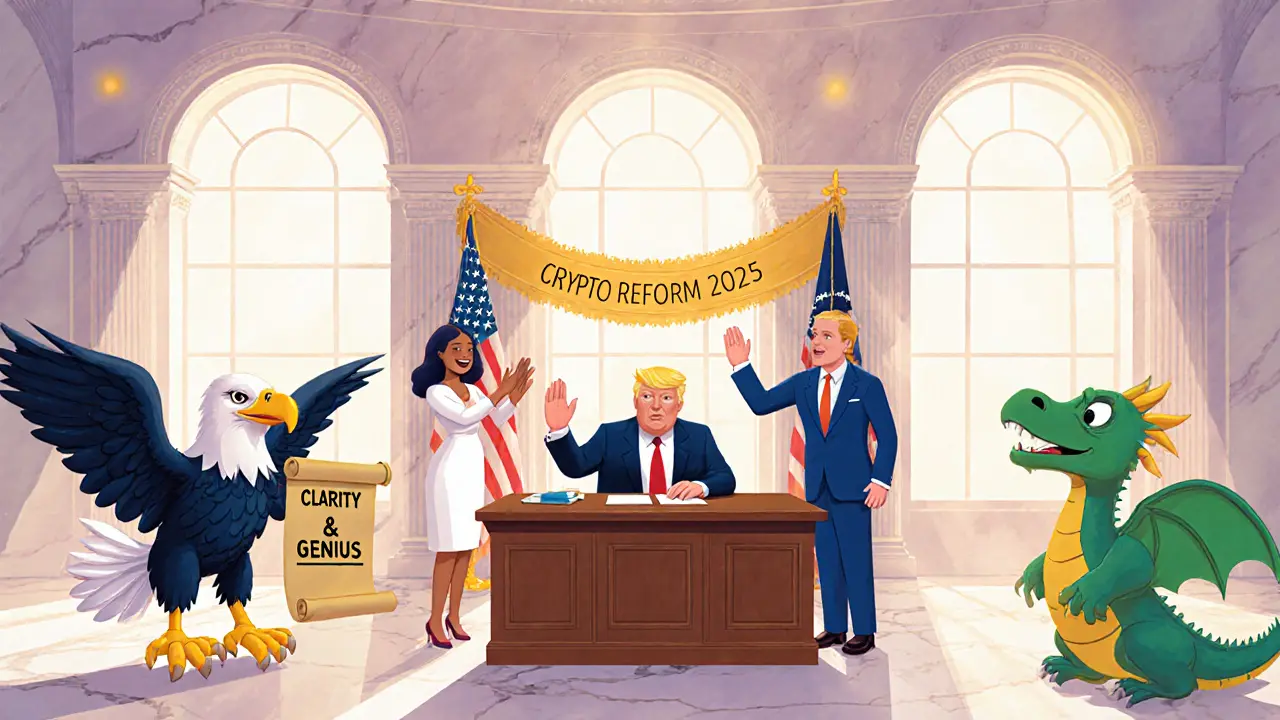Crypto Token Classifier Tool
This tool helps classify digital tokens according to the CLARITY Act framework:
- Digital Commodity – decentralized blockchain tokens (e.g., BTC, ETH)
- Investment Contract – security-like tokens (e.g., ICOs, STOs)
- Payment Stablecoin – fiat-backed payment tokens (e.g., USD Coin, USDC)
Regulatory Authority:
Key Compliance Requirements:
Key Takeaways
- The Digital Asset Market CLARITY Act creates a three‑tier framework that classifies tokens as digital commodities, investment contracts, or payment stablecoins and hands enforcement to the CFTC for the first two categories.
- The GENIUS Act imposes 100% reserve backing, monthly disclosures, and creditor‑priority rules for stablecoins, tightening consumer protection.
- The Office of the Comptroller of the Currency (OCC) now allows national banks to offer crypto custody and participate in node verification networks.
- State regulators still vary widely, but federal certainty is expected to spur a 40‑60% rise in institutional crypto participation over the next 18 months.
- Businesses must register with the CFTC for digital‑commodity activities and meet SEC reporting for investment‑contract assets, while stablecoin issuers face new reserve‑audit obligations.
Ever wondered why you can finally hear about crypto on mainstream news without a legal disclaimer? The answer lies in a flurry of 2025 legislation that finally puts the United States on a single regulatory track. This article walks through the biggest bills, the agencies now in charge, and what the changes mean for anyone holding or building digital assets.
Why the Legal Landscape Needed a Reset
Before 2025, the crypto world in the U.S. was a patchwork of lawsuits, agency warnings, and state‑by‑state rules. The SEC sued major exchanges for allegedly offering securities, the CFTC chased after futures‑style trades, and banks were told to stay away from crypto custody. The result? Institutional investors hesitated, startups faced endless compliance guesswork, and everyday users were left with unclear consumer protections.
Two landmark pieces of legislation in 2025 aimed to end that uncertainty. They were backed by a bipartisan House vote (294‑134) and signed by then‑President Donald J. Trump, signaling that crypto was finally being treated as a mainstream financial asset rather than a fringe experiment.
The Digital Asset Market CLARITY Act
At its core, the CLARITY Act creates a clear three‑tier classification for digital tokens and assigns each tier to a specific regulator. The three categories are:
- Digital Commodity - tokens on sufficiently decentralized blockchains (e.g., Bitcoin, Ether). These fall under CFTC oversight.
- Investment Contract - tokens that function like securities, subject to SEC registration and reporting.
- Payment Stablecoin - stablecoins used for payments, overseen by banking regulators under the GENIUS Act.
By defining “digital commodity,” the Act gives the CFTC exclusive authority over anti‑fraud and manipulation enforcement for spot transactions. It also tells crypto exchanges that if they want to list a token as a commodity, they must register with the CFTC and adopt standard AML and trade‑surveillance measures.

The GENIUS Act: Stablecoins Under a Microscope
Stablecoins have always been the regulatory wild card because they blend crypto tech with fiat‑backed promises. The GENIUS Act requires 100% reserve backing, monthly public reserve disclosures, and gives stablecoin holders priority in bankruptcy addresses those concerns head‑on.
- Issuers must hold reserves in U.S. dollars or short‑term Treasury securities-no exotic assets.
- Every month they publish a detailed reserve composition report, making it easy for auditors and users to verify solvency.
- If a stablecoin issuer collapses, its holders outrank all other creditors, creating a safety net similar to FDIC protection for banks.
- Misleading claims that a stablecoin is “government‑backed” or “legally tender” are now prohibited, cutting down on marketing hype.
These rules are stricter than most other jurisdictions, which often accept 99% backing or allow liquidity‑risk assets in the reserve pool.
Who’s In Charge? CFTC, SEC, and the OCC
The split of authority is now crystal clear:
- The CFTC oversees digital commodities and enforces anti‑manipulation rules for spot markets.
- The SEC regulates investment‑contract assets, requiring registration and periodic reporting similar to traditional securities.
- The OCC has lifted previous bans, allowing national banks and federal savings associations to provide crypto custody and to join independent node verification networks.
What this means for a crypto exchange is simple: if you trade Bitcoin or Ether, you need a CFTC registration; if you issue a token that passes the Howey test, you need an SEC registration; and if you offer a payment stablecoin, you must follow GENIUS‑Act reserve rules and file regular disclosures.
State‑Level Moves: A Mixed Bag
Even with a federal framework, states keep testing their own approaches. California’s AB2269 demands a license from the Department of Financial Protection and Innovation before any digital‑asset business can operate, effectively tightening the leash on unregistered platforms. Colorado, on the other hand, passed a 2019 Digital Token Act that lets crypto firms skip certain securities filings if they simply notify the state securities commissioner.
These divergent rules matter because many crypto startups launch in one state and expand nationally. The federal CLARITY and GENIUS acts set a baseline, but businesses still need to check their home‑state requirements to avoid penalties.

Practical Implications for Crypto Companies
If you run a crypto‑related business, here’s a quick checklist:
- Determine token classification (digital commodity, investment contract, or payment stablecoin).
- Register with the appropriate federal agency - CFTC or SEC - and file the required forms.
- For stablecoins, set up a 100% reserve pool of U.S. dollars or Treasury bills and schedule monthly public disclosures.
- Review state licensing rules where you have a physical presence or where your users are concentrated.
- Implement AML/KYC programs that satisfy both CFTC and SEC expectations - the same system can often satisfy both.
- If you’re a bank, work with the OCC’s new guidance to launch crypto custody services without a supervisory non‑objection.
Companies that ignore the registration step risk enforcement actions similar to the SEC’s 2023 lawsuits against Coinbase and Kraken. Smaller platforms have voiced concerns about compliance costs, but many are already budgeting for legal teams, given the potential upside of a clearer market.
Comparison of Token Classifications
| Category | Key Criteria | Primary Regulator | Typical Compliance |
|---|---|---|---|
| Digital Commodity | Decentralized blockchain, no single controlling entity | CFTC | CFTC registration, AML, trade surveillance |
| Investment Contract | Passes Howey test - expectation of profit from others' efforts | SEC | SEC registration, periodic reporting, investor disclosures |
| Payment Stablecoin | Stable value pegged to fiat, used for payments | Banking regulators (OCC, FDIC) under GENIUS Act | 100% reserve backing, monthly reserve statements, creditor‑priority rules |
What the Future Holds
Analysts at State Street predict a 40‑60% jump in traditional banks entering the digital‑asset space within a year and a half of full rule implementation. That surge will likely bring more liquidity, better custodial services, and broader acceptance of crypto in everyday transactions.
However, two challenges remain. First, the “sufficiently decentralized” test for digital commodities is still fuzzy - regulators will need clear metrics to decide when a project crosses the line. Second, the U.S. must align its rules with emerging international standards, especially on cross‑border stablecoin flows.
For now, the biggest win is certainty. When a regulator tells you exactly where to file and what to disclose, you can focus on building products instead of litigating. If you’re a developer, an investor, or just a curious user, keeping an eye on CFTC rulemakings and SEC guidance will be essential as the agencies flesh out the details in the coming months.
Frequently Asked Questions
What is the main difference between a digital commodity and an investment contract?
A digital commodity is a token that runs on a truly decentralized network - think Bitcoin or Ether - and is regulated by the CFTC. An investment contract behaves like a security, meaning investors expect profits from the efforts of a central team; it falls under SEC jurisdiction.
Do stablecoin issuers need to be registered with the SEC?
No. Stablecoins used for payments are covered by the GENIUS Act, which is enforced by banking regulators, not the SEC. The key requirements are 100% reserve backing and monthly public reserve disclosures.
How does the OCC’s new guidance affect banks?
The OCC now allows national banks and federal savings associations to offer crypto custody services and to join independent node verification networks without seeking a special supervisory non‑objection. This opens the door for traditional banks to compete with crypto‑native custodians.
Will the CLARITY Act apply retroactively to tokens launched before 2025?
The Act includes a transition period during which existing tokens must either meet the digital‑commodity criteria or re‑classify as investment contracts. Platforms have up to 12 months to register with the appropriate agency.
What are the penalties for misrepresenting a stablecoin’s backing?
Violations of the GENIUS Act can lead to civil penalties of up to $1million per offense, plus potential injunctions that force the issuer to cease operations until compliance is achieved.







Anastasia Alamanou
October 10, 2025 AT 19:39The CLARITY Act finally gives us a taxonomy that doesn’t require a law degree to parse. Digital commodity, investment contract, payment stablecoin - it’s clean, it’s actionable, and most importantly, it’s enforceable. No more ‘it depends’ from regulators. The CFTC’s jurisdiction over spot markets is a win for decentralization purists, and the SEC’s clear Howey test application shuts down the gray-area ICOs once and for all.
Stablecoins under GENIUS? Long overdue. 100% reserves aren’t just prudent - they’re non-negotiable. The creditor-priority clause is genius; it turns stablecoins from speculative bets into functional money. No more Terra-style collapses where users get wiped while VCs get paid first.
What’s missing? A standardized on-chain disclosure protocol. If issuers are publishing monthly reserve statements, why not make them verifiable via smart contract? That’s the next frontier - transparency baked into the protocol, not just in PDFs buried on a website.
Rohit Sreenath
October 11, 2025 AT 02:37This is just another way for the system to control people. They call it clarity but it’s really control. You think Bitcoin is free? Now you need permission from CFTC to hold it. SEC wants to regulate every coin that even looks like it might make you money. And stablecoins? They’re forcing banks to be the gatekeepers again. This isn’t innovation - it’s re-centralization with fancy labels.
Sam Kessler
October 11, 2025 AT 12:26Let’s be real - this whole framework is a PR stunt wrapped in legislative glitter. The CFTC? They’ve been chasing crypto for a decade and still don’t understand the tech. The SEC? They’re treating every token like a Ponzi scheme because they’re terrified of losing power. And the OCC letting banks do custody? That’s just Wall Street putting a velvet glove on a steel fist.
And don’t get me started on ‘sufficiently decentralized’ - that’s not a legal standard, it’s a Rorschach test for regulators. One day Ether is a commodity, the next it’s a security because someone at the CFTC had a bad coffee. This isn’t regulation - it’s regulatory theater with a side of FUD.
Meanwhile, the real innovation is happening in places where they don’t have these laws. You think this ‘clarity’ will stop DeFi? It’ll just drive it offshore - and then we’ll have to deal with unregulated offshore stablecoins backed by Chinese state funds. Thanks, Congress.
Steve Roberts
October 11, 2025 AT 20:36Oh please. You call this clarity? You’ve created three boxes and then spent 50 pages telling us how to shove things into them - while leaving the door wide open for endless litigation. ‘Sufficiently decentralized’? Who decides? The CFTC? The same agency that still thinks NFTs are ‘securities’ if they have a JPEG? This isn’t a framework - it’s a minefield with a label.
And let’s not pretend the GENIUS Act is consumer protection. It’s a bailout for big stablecoin issuers who can afford lawyers and auditors. Small players? They’re dead on arrival. This isn’t about protecting users - it’s about protecting the banking oligopoly from disruption.
And don’t even get me started on banks doing custody. That’s like letting the fox design the chicken coop. You think JPMorgan’s crypto custody is going to be open, transparent, and fair? Please. It’s a walled garden with a compliance sticker.
John Dixon
October 12, 2025 AT 14:38Oh wow. The U.S. finally got around to regulating crypto… by copying the EU’s MiCA and calling it ‘CLARITY.’ Brilliant. And now we have a 100% reserve rule for stablecoins - which, shockingly, is exactly what every economist said since 2018. So… we’re 7 years late? Congrats. You just spent $100 million to confirm that money should be backed by money. Who knew?
Also, ‘payment stablecoin’? That’s not a category - that’s a marketing term. USDC is a bank liability with a blockchain wrapper. Calling it a ‘token’ doesn’t make it magic. And the OCC letting banks do custody? That’s not innovation - it’s a backdoor for the Fed to control DeFi by proxy. We didn’t get clarity. We got bureaucracy with a crypto logo.
Brody Dixon
October 12, 2025 AT 23:22I’ve been watching this space for years - from the wild west days of 2017 to the regulatory chaos of 2023. This feels like the first time we’re not just reacting to fires, but building a fire escape. The token classifier tool? That’s actually useful. I’ve shown it to three friends who were confused about their holdings.
Yes, the language is still technical, and yes, compliance will be a headache for small teams - but at least now there’s a map. No more guessing if your token is a security. No more ‘we’re a utility’ excuses when it’s clearly a fundraising vehicle.
The 100% reserve rule for stablecoins? That’s the quiet hero here. It’s not sexy, but it’s what saves people from losing everything. And banks finally being allowed to participate? That’s how this becomes mainstream - not through hype, but through trust.
It’s not perfect. But it’s a start. And for the first time in a decade, I feel like I can tell my dad what I do for work without him worrying I’m in a pyramid scheme.